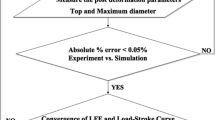Abstract
With the objective of evaluating the accuracy of the upper-bound theory for calculating the average Tresca friction coefficient m in the hot forging process, we performed simulations using different values of m in each compression process to high strain levels. It was found that the upper-bound theory is not applicable at high strain levels, because the contact surface of the cylindrical sample is composed of an originally flat end surface and the annular portion formed by the contact of the lateral surface with the anvil surface. The relation among \( P = {\frac{{R_{m} H}}{{R_{t} H_{0} }}}, \) true strain, and m could be expressed by \( \left( {a^{\prime} + a^{\prime\prime}\varepsilon + a^{\prime\prime\prime}\varepsilon^{2} - P} \right) + \left( {b^{\prime} + b^{\prime\prime}\varepsilon + b^{\prime\prime\prime}\varepsilon^{2} } \right)m\,+ \left( {c^{\prime\prime}\varepsilon + c^{\prime\prime\prime}\varepsilon^{2} } \right)m^{2} = 0. \) Here, the m values obtained were in good agreement with the actual ones used in the simulations. The value of m of the arbitrary geometry cylindrical sample could also be directly read from a contour map with a relationship among nominal strain, parameter B of the corresponding standard sample, and m.













Similar content being viewed by others
References
N. Frederiksen and T. Wanheim: J. Mech. Work. Technol., 1985, vol. 12, pp. 261–68.
N. Bay: J. Mech. Work. Technol., 1987, vol. 14, pp. 203–23.
A.T. Male and V. Depierre: J. Lubr. Technol., 1970, vol. 92, pp. 389–97.
S. Venugopal, G. Srinivasan, S. Venkadesoan, and V. Seetharaman: J. Mech. Work. Technol., 1989, vol. 19, pp. 261–66.
G. Shen, V. Vedhanayagam, E. Kropp, and T. Altan: J. Mater. Process Technol., 1992, vol. 33, pp. 109–23.
A. Bushhausen, K. Weinmann, J.Y. Lee, and T. Altan: J. Mater. Process. Technol., 1992, vol. 33, pp. 95–108.
N. Bay, J. Hunding, K. Kuzman, and E. Pfeifer: Proc. 5th Int. Conf. on Technology of Plasticity, Columbus, OH, 1996, pp. 311–18.
R. Ebrahimi and A. Najafizadeh: J. Mater. Proc. Technol., 2004, vol. 152, pp. 136–43.
R. Ebrahimi, A. Najafizadeh, and R. Shateri: Proc. Steel Symp. 81, Iranian Institute for Iron and Steel, Isphahan, Iran, Mar. 2–3, 2003, pp. 230–37.
Y. Li, E. Onodera, H. Matsumoto, and A. Chiba: Metall. Mater. Trans. A, 2009, vol. 40A, pp. 982–90.
Y. Li, H. Matsumoto, and A. Chiba: Metall. Mater. Trans. A, 2009, vol. 40A, pp. 1203–09.
Y. Li, E. Onodera, H. Matsumoto, and A. Chiba: unpublished research, 2009.
B. Avitzur and R.A. Kohser: ASME J. Eng. Ind., 1978, vol. 100, pp. 421–33.
T. Thore and E. Felder: J. Mech. Work. Technol., 1986, vol. 13, pp. 51–64.
K. Phlandt and T. Oberlnder: J. Mater. Proc. Technol., 1992, vol. 34, pp. 187–94.
H. Monajati, M. Jahazi, S. Yue, and A.K. Taheri: Metall. Mater. Trans. A, 2005, vol. 36A, pp. 895–905.
G.E. Dieter: Mechanical Metallurgy, 3rd ed., McGraw Hill Book Co., New York, NY, 1986, p. 539.
S.I. Oh, S.L. Semiatin, and J.J. Jonas: Metall. Trans. A, 1992, vol. 23A, pp. 963–75.
P. Daras and J.F. Thomas: Metall. Trans. A, 1981, vol. 12A, pp. 1867–76.
C.C. Chen: “Evaluation of Lubrication Systems for Isothermal Forging of Alpha-Beta Titanium Alloys,” AFML-Tr-77-181, AFWAL Materials Laboratory, WP-AFB, OH 1977.
Acknowledgments
This research was supported by a Cooperation of Innovative Technology and Advanced Research in Evolutional Area from the Ministry of Education, Culture, Sports, Science and Technology of Japan. The authors of this research thank Yamanaka Eng. Co. Ltd. (Osaka, Japan) for partly supporting this research.
Author information
Authors and Affiliations
Corresponding author
Additional information
Manuscript submitted March 4, 2009.
Rights and permissions
About this article
Cite this article
Li, Y., Onodera, E. & Chiba, A. Evaluation of Friction Coefficient by Simulation in Bulk Metal Forming Process. Metall Mater Trans A 41, 224–232 (2010). https://doi.org/10.1007/s11661-009-0066-0
Published:
Issue Date:
DOI: https://doi.org/10.1007/s11661-009-0066-0



